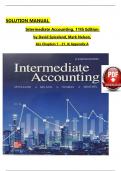Examen
Solution Manual For Intermediate Accounting, 11th Edition by David Spiceland, Mark Nelson, Verified Chapters 1 - 21 & Appendix A, Complete Newest Version
- Grado
- Institución
Solution Manual For Intermediate Accounting, 11th Edition by David Spiceland, Mark Nelson, Verified Chapters 1 - 21 & Appendix A, Complete Newest Version Solution Manual For Intermediate Accounting, 11th Edition by David Spiceland, Mark Nelson, Verified Chapters 1 - 21 & Appendix A, Complete Newes...
[Mostrar más]



